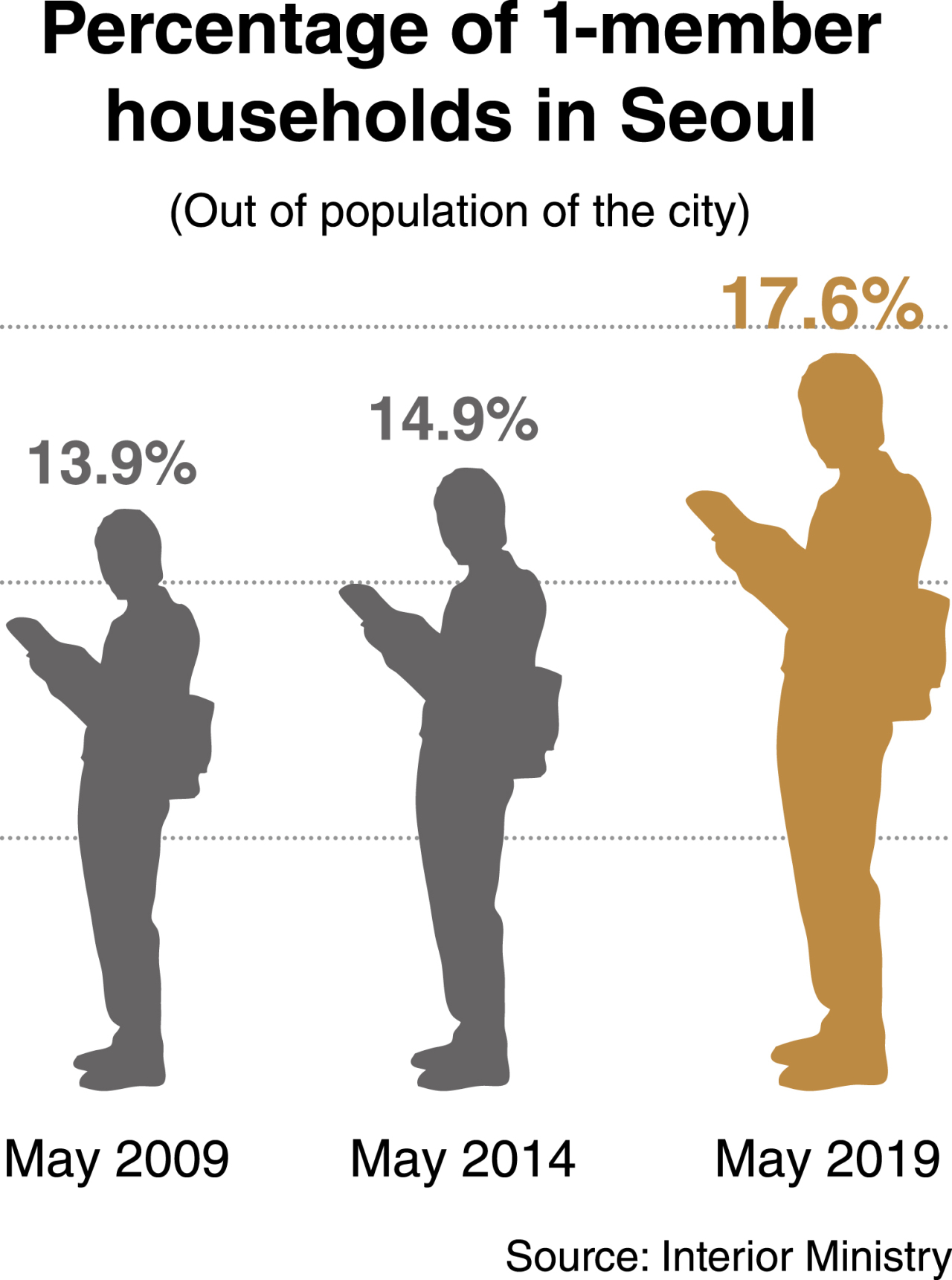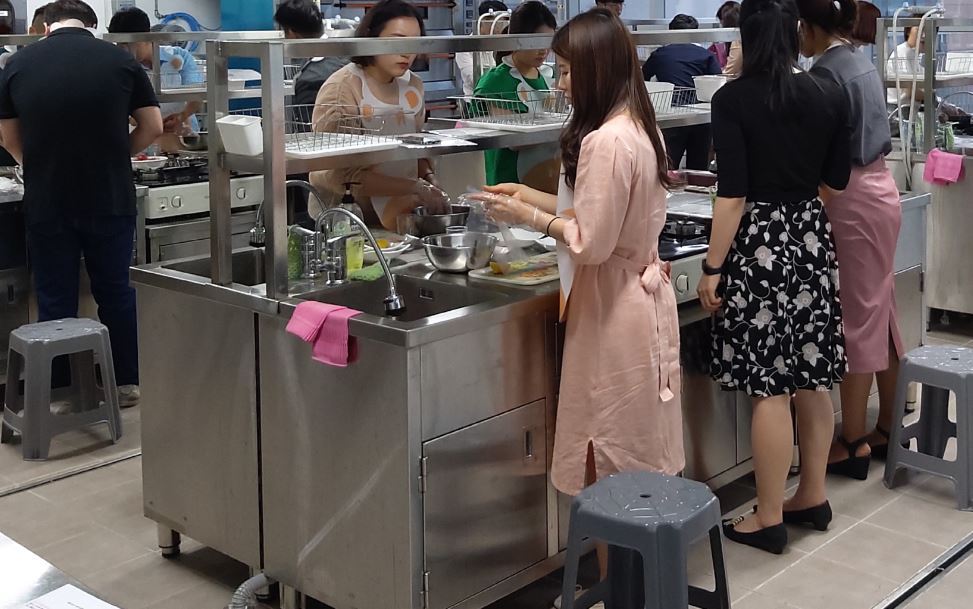[News Focus] 17% of Seoul citizens reside alone in 2019
By Kim Yon-sePublished : June 6, 2019 - 16:32
SEJONG -- A core demographic change in South Korea in recent years is the rapidly growing number of single-person households.
The trend is especially strong in Seoul as younger people working in the capital seem more reluctant to get married amid uncertainty over finances, job security and their prospects of being able to purchase apartments.
The trend is especially strong in Seoul as younger people working in the capital seem more reluctant to get married amid uncertainty over finances, job security and their prospects of being able to purchase apartments.

According to the Ministry of Interior and Safety, the number of single-person households in Seoul was 1.51 million five years ago in May 2014, when the city’s population stood at 10.13 million. At that time, the proportion of Seoulites residing alone was 14.9 percent.
Since then, the number of single-person households has increased by about 200,000 and recorded 1.71 million in May 2019, despite the apparent decrease in Seoul’s population to 9.76 million.
That means the proportion of citizens residing alone reached 17.6 percent as of last month -- an increase of 2.7 percentage points over the 60-month period.
The corresponding figure was 13.9 percent 10 years ago, said a government official in Sejong Autonomous City. Living alone in greater numbers is a trend not only among young and middle-aged Seoulites, but elderly people too, he said.
Of the city’s 25 districts, Gwanak-gu had the greatest number of single-person households, 147,800. It was followed by Gangseo-gu at 100,600, Songpa-gu at 94,100, Gangnam-gu at 89,900, Yeongdeungpo-gu at 79,100, Mapo-gu at 77,100 and Dongjak-gu at 76,000.
People living alone in Seoul, at 1.71 million, outnumber the population (1.48 million) of Daejeon, the nation’s fifth-largest city.
In proportion to the general population, the 17.6 percent of Seoulites living alone exceed the nationwide average of 15.9 percent. The average number of residents per household in Seoul stood at 2.27 as of May 2019, as compared with 2.42 in May 2014 and 2.49 in May 2009.
Ministry data also showed that 61 percent, or 2.62 million, of the 4.30 million households in the capital consist of one or two people.
Three-member households numbered 768,000, trailed by four-member households at 694,000, five-member households at 164,000 and six-member households at 36,000.
Meanwhile, the population of Seoul decreased 460,000, or 4.5 percent, over the past 10 years in inverse proportion to the total population.
Demographic research analysts share the view that the trend toward more and more single-person households was spreading rapidly across major cities and rural areas. They cite low fertility rates, rising divorce rates, falling marriage rates and the movement of young people born in farming districts to urban districts.
Nationwide, people living alone accounted for 12.1 percent of the general population (6.03 million out of 49.61 million) 10 years ago, 13.5 percent (6.95 million of 51.21 million) five years ago and 15.1 percent (7.87 million of 51.79 million) one year ago.
That figure had climbed to 15.9 percent as of May 2019 -- 8.27 million people in a population of 51.84 million.
This indicates that the number of people residing alone in Korea surged 37.1 percent over the past decade, while population growth was just 4.4 percent.

Of all regions throughout the nation, Gyeonggi Province had the highest number of one-member households, 1.82 million, though people living alone accounted for a smaller proportion of the general population than their counterparts in Seoul. Busan was in third place with 543,000, followed by South Gyeongsang Province with 517,000, North Gyeongsang Province with 489,000 and Incheon with 417,000. Sejong recorded the lowest number at 41,000.
Nationwide, the average number of residents per household stood at 2.33 as of last month, compared with 2.49 in May 2014 and 2.60 in May 2009.
Among the major cities, Sejong topped the list with 2.52 members per household. It was trailed by Ulsan at 2.48, Incheon at 2.41, Daegu and Gwangju at 2.39 each and Daejeon at 2.35.
Seoul and Busan were both behind the nationwide average with 2.27 and 2.30, respectively, and Gangwon Province was at the bottom with 2.16.
By Kim Yon-se (kys@heraldcorp.com)






![[From the Scene] Monks, Buddhists hail return of remains of Buddhas](http://res.heraldm.com/phpwas/restmb_idxmake.php?idx=644&simg=/content/image/2024/04/19/20240419050617_0.jpg&u=20240419175937)







![[From the Scene] Monks, Buddhists hail return of remains of Buddhas](http://res.heraldm.com/phpwas/restmb_idxmake.php?idx=652&simg=/content/image/2024/04/19/20240419050617_0.jpg&u=20240419175937)

![[KH Explains] Hyundai's full hybrid edge to pay off amid slow transition to pure EVs](http://res.heraldm.com/phpwas/restmb_idxmake.php?idx=652&simg=/content/image/2024/04/18/20240418050645_0.jpg&u=20240419100350)

![[Today’s K-pop] Illit drops debut single remix](http://res.heraldm.com/phpwas/restmb_idxmake.php?idx=642&simg=/content/image/2024/04/19/20240419050612_0.jpg&u=)